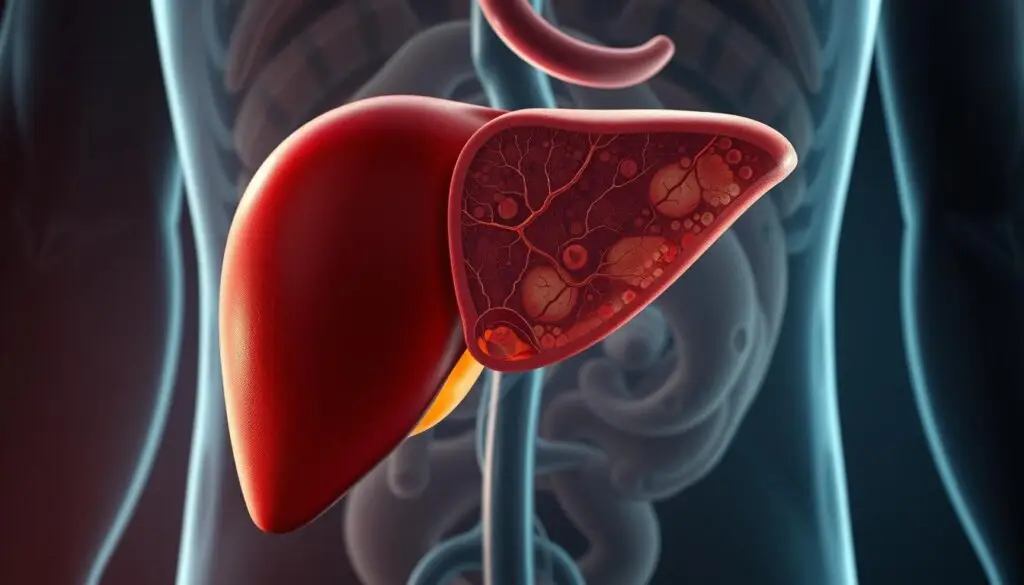Protecting your liver health starts with noticing small changes. Your liver is a hardworking organ that quietly filters blood, stores energy, and supports digestion.
When symptoms appear—fatigue, mild jaundice, or belly discomfort—they act as a prompt to act. Spotting issues early gives you the best chance to slow progression through the stages of liver disease.
This guide explains what to watch for, why changes happen, and which factors you can control to cut risk. It shows simple steps to protect your long-term liver function and the tests doctors use to confirm problems.
Take action now by learning the key symptoms and when to call your clinician. Small changes today can prevent serious disease and help keep your body working well.
Key Takeaways
- Recognize common symptoms like fatigue, jaundice, and abdominal swelling.
- Understand the stages of liver disease and why early detection matters.
- Manage controllable factors—diet, alcohol, and medications—to lower risk.
- Simple tests can confirm liver problems; seek care promptly.
- Early intervention can reverse some damage and slow progression.
Why your liver health matters right now: what your liver does and how damage begins
Behind the scenes, the liver balances metabolism and defends the body against chemical and infectious threats.
Filtering blood, making bile, balancing metabolism and immunity
Your liver filters waste from your blood and makes bile so you can digest fats and absorb vitamins. It stores energy and releases it when you need fuel.
This organ also helps regulate metabolism and supports immune responses that protect the rest of your body.
Why toxins, infections, and metabolic stress overwhelm liver function
Because the liver constantly processes chemicals, infections like hepatitis or repeated exposure to alcohol and fatty liver disease can push it past capacity.
Ongoing insult leads to inflammation and scar formation. Scar tissue cuts blood flow, so liver cells get less oxygen and nutrients and performance slips.
You can act—reducing alcohol, treating hepatitis, and managing metabolic risks gives the liver a chance to recover before damage becomes permanent.
| Cause | Short-term effect | Long-term risk |
|---|---|---|
| Viral hepatitis | Inflammation, fatigue | Chronic hepatitis, fibrosis |
| Alcohol excess | Metabolic stress | Progressive scarring, cirrhosis |
| Fatty liver disease | Impaired bile processing | Fibrosis and reduced liver function |
From inflammation to failure: understanding stages of liver disease and what you might feel first
The body compensates for lost liver function until a tipping point reveals harder-to-ignore problems. That transition marks the move from mild inflammation toward scarring and, in some cases, failure.

Hepatitis and early fibrosis: subtle symptoms that are easy to overlook
Hepatitis often begins with vague fatigue, mild appetite change, or a dull ache under the right ribs. These signs may appear even before routine labs shift noticeably.
Early fibrosis builds slowly. Scar tissue can accumulate while you feel mostly well. That is why screening matters if you have risk factors.
Cirrhosis and decompensation: when complications expose hidden damage
As cirrhosis advances, your body can no longer hide the loss of function. Fluid in the abdomen, easy bruising, or mental clouding may surface.
Decompensation brings clear complications: rapid swelling, new jaundice, or confusion from toxins in the blood. At that point, close medical care is essential to prevent worse outcomes.
| Stage | Main process | Common early symptom |
|---|---|---|
| Hepatitis | Inflammation | Fatigue, mild discomfort |
| Fibrosis | Scar buildup | Often minimal symptoms |
| Cirrhosis | Permanent scarring | Fluid buildup, bruising |
| Decompensation | Organ failure effects | Jaundice, confusion |
Act early when vague complaints arise. Learn more about specific hepatitis changes at signs of hepatitis so you and your clinician can pick the right monitoring and treatment.
Early Signs of Liver Disease You Should Never Ignore
Small, persistent changes in how you feel can mark the earliest phase of liver trouble. Pay attention to clusters of symptoms rather than a single complaint.

Persistent fatigue and brain fog
You may feel tired despite rest. Toxin buildup happens when the liver cannot clear blood well. That creates low energy and trouble concentrating.
Jaundice and dark urine
Yellowing of the skin or eyes and dark urine point to bilirubin handling problems. Jaundice needs prompt evaluation to find the cause and limit further damage.
Pale stool, bloating, and abdominal pain
Pale or clay-colored stool and frequent gassiness show bile is not reaching the gut. New abdominal pain or swelling may mean inflammation or fluid buildup.
Swelling, itchy skin, bleeding, weight loss, and confusion
Leg or ankle swelling signals fluid imbalance. Itchy skin can come from bile salts irritating nerves.
Easy bruising or prolonged bleeding means clotting factors are low and blood risks rise. Loss of appetite, sudden weight loss, and muscle weakness suggest poor nutrient processing.
Confusion or disorientation can be hepatic encephalopathy — seek urgent care if this appears.
What’s driving the damage: common causes and risk factors you can change
Several controllable factors drive most progressive liver damage in adults. Knowing the main causes helps you take specific steps to protect your health.
Chronic alcohol use and alcohol-related liver disease
Regular heavy alcohol use sharply raises the chance of inflammation and scarring. Cutting back or quitting alcohol is the single most effective move to slow damage in many people.
Viral hepatitis B and C: why screening and antivirals matter
Both viral hepatitis strains can quietly injure the liver for years. Ask your clinician about testing—effective antivirals can stop progression and lower long-term disease.
Non-alcoholic fatty liver disease and metabolic ties
Fatty liver often links to obesity, diabetes, and high cholesterol. Simple changes in diet, weight, and activity can reverse early fatty liver and reduce damage.
Autoimmune, genetic, and medication-related causes
Autoimmune hepatitis, Wilson’s disease, hemochromatosis, and some drugs or toxins also cause harm. Targeted evaluation can find treatable causes before complications develop.
Takeaway: You can lower risk fast by addressing causes you control—reduce alcohol, manage weight and metabolic conditions, and get screened for viral hepatitis. Combine lifestyle change with medical care and track progress with your clinician; this dual plan gives the best chance to halt or reverse damage.
For detailed guidance on screening and managing chronic causes, see screening and treatment for chronic causes.
When to call the doctor now: red flags, labs, and imaging that confirm liver disease
Act quickly if you see sudden, severe changes. Some problems require emergency care because they can lead to rapid decline.
Urgent symptoms
Call your doctor or 911 now if you vomit blood, develop severe belly swelling, or have worsening confusion. These signs can mean variceal bleeding, large ascites, or hepatic encephalopathy tied to cirrhosis and other complications.
Don’t wait if you notice fast yellowing of the eyes, very dark urine, or quickly increasing leg swelling. Each signals a step-up in disease that needs prompt evaluation.
Tests that tell the story
Expect blood tests that check liver enzymes (AST/ALT), bilirubin, and clotting (INR). These labs show how well your liver is functioning and the risk of bleeding.
Imaging such as ultrasound and elastography gives a clear, noninvasive look at scarring and cirrhosis. Together, labs and scans guide the right treatment plan fast.
- If tests show decompensation, your team will act to stop bleeding, manage fluid buildup, and treat confusion to prevent life‑threatening complications.
- Bring a list of all medications and supplements so clinicians can avoid harmful interactions and refine your medications safely.
Protecting your liver: proven lifestyle changes and treatments that make a difference
Simple changes in daily habits can halt or even reverse early fat buildup inside the liver. Start with clear, achievable steps and pair them with medical care when needed.
Cutting alcohol, improving diet, and losing weight are the most powerful moves for non-alcoholic fatty liver. Remove alcohol completely and aim for steady weight loss through a balanced diet and regular activity.
Build meals around whole food: vegetables, fruit, lean protein, and whole grains. Reduce added sugars and ultra-processed food to lower liver inflammation and ease metabolic stress.
Medications that stop inflammation at the source
If hepatitis affects your liver, ask your clinician about modern antiviral treatment that can halt viral damage. For autoimmune conditions, targeted immunosuppressive medications can reduce inflammation and preserve function.
Managing cirrhosis and when transplant is considered
With cirrhosis, care focuses on complications. Your team may use diuretics and sodium restriction for ascites, perform paracentesis when fluid is large, treat encephalopathy, and control variceal bleeding with endoscopic therapy.
If disease progresses despite optimal care, timely evaluation for liver transplant can be life‑saving. Discuss referral early so you and your team can plan next steps without delay.
- Start now: stop alcohol, improve diet quality, and target gradual weight loss.
- Combine habits with treatment: medications for hepatitis or autoimmune disease reduce progression.
- Stay engaged: regular follow-up keeps complications manageable and opens timely transplant options when needed.
Conclusion
Small, persistent changes in energy, skin tone, or digestion may signal that your liver needs attention. Spotting these shifts early gives the best chance to slow liver damage and protect liver function.
Address key factors—alcohol use, viral hepatitis, and metabolic risks—with clear steps: improve diet, aim for steady weight loss, and review medications with your clinician. For fatty liver disease and inflammation, lifestyle combined with targeted meds can reverse or halt harm before cirrhosis develops.
If you notice yellowing skin, growing swelling, or confusion, seek care quickly. Timely testing and treatment reduce complications, preserve blood‑filtering function, and lower the chance of late‑stage disease. Make a plan with your clinician and keep listening to your body.



